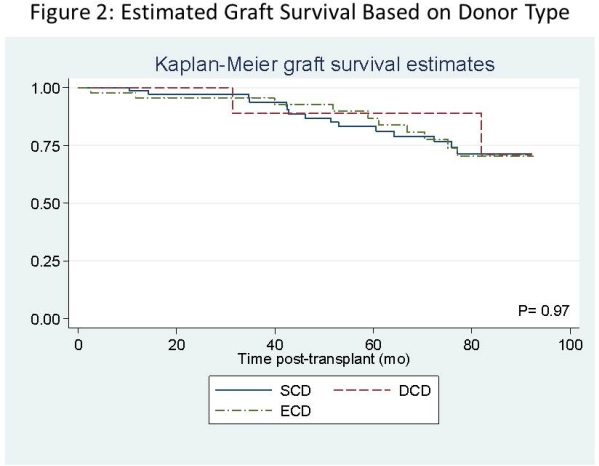Kidney Allocation Tool of the Future: The Estimated Post-Transplant Survival (EPTS) Score
University of Maryland, Baltimore.
Meeting: 2015 American Transplant Congress
Abstract number: A140
Keywords: Graft survival, Kidney transplantation, Prediction models
Session Information
Session Name: Poster Session A: Kidney Candidate Issues and Outcomes
Session Type: Poster Session
Date: Saturday, May 2, 2015
Session Time: 5:30pm-7:30pm
 Presentation Time: 5:30pm-7:30pm
Presentation Time: 5:30pm-7:30pm
Location: Exhibit Hall E
Background:
Beginning December 2014, a new kidney transplant allocation system will be used. A component of this system is the Estimated Post-Transplant Survival (EPTS) score, which will be utilized for allocation of donors with lower Kidney Donor Profile Index (KDPI). We aimed to assess EPTS scores in our deceased donor renal transplant (DDRT) population over a range of KDPI.
Methods:
All DDRT recipients between 12/2006-11/2007 were included. KDPI and EPTS scores were calculated for both donors and recipients. Patients were stratified into three groups based on EPTS score (%): 1-20, 21-79, 80-100. Primary outcomes included patient survival and graft loss across these groups.
Results:
During the study period 154 patients were identified, of which 54 received expanded criteria donors (ECD) and 13 received donation after cardiac death (DCD). Patient characteristics are summarized in Table 1. During follow-up, 29 patients (18.8%) experienced graft loss. Overall, graft loss did not differ based on EPTS score (HR=0.63, p=0.28) or donor type (HR=1.2, p=0.47). Lower EPTS scores (1-20%) were not associated with better outcomes. Estimated graft survival based on these variables is summarized below.
| Parameter | Result (N,%) |
| Male | 101 (64.7) |
| Age (mean ±SD | 53.9 ±13 years |
| African-American | 83 (53.2) |
| SCD only | 87 (56.5) |
| DCD only | 13 (8.4) |
| ECD only | 54 (34.8) |
| T-cell depleting induction | 107 (69.5) |
| Basiliximab | 49 (31.4) |
| EPTS 1-20% | 24 (15.6) |
| EPTS 21-79% | 95 (61.7) |
| EPTS 80-'00% | 24 (15.6) |


Conclusions:
Our retrospective application of the EPTS scoring system to our deceased donor population did not correlate with patient survival and graft loss, regardless of donor type or KDPI. These results are limited by our small sample size. Prospective studies evaluating the applicability of this new scoring system are warranted.
To cite this abstract in AMA style:
Moss M, Gillespie M, Sparkes T, Ravichandran B, Ugarte R, Haririan A. Kidney Allocation Tool of the Future: The Estimated Post-Transplant Survival (EPTS) Score [abstract]. Am J Transplant. 2015; 15 (suppl 3). https://atcmeetingabstracts.com/abstract/kidney-allocation-tool-of-the-future-the-estimated-post-transplant-survival-epts-score/. Accessed January 6, 2026.« Back to 2015 American Transplant Congress
